Rigid veneer offers a durable, long-lasting finish ideal for structural applications, while flexible veneer provides adaptability for curved or irregular surfaces, enhancing design versatility. Your choice depends on the project's specific needs, balancing strength and flexibility for optimal aesthetic and functional results.
Table of Comparison
| Feature | Rigid Veneer | Flexible Veneer |
|---|---|---|
| Material Type | Solid thin wood sheets | Thin, bendable wood sheets |
| Flexibility | Low flexibility, rigid structure | High flexibility, suitable for curved surfaces |
| Applications | Flat surfaces like furniture panels, doors | Curved furniture, rounded edges, complex shapes |
| Installation | Requires flat, stable substrate | Can conform to irregular shapes and contours |
| Durability | Highly durable and stable | Moderate durability, prone to damage if overstretched |
| Cost | Typically lower cost | Usually higher cost due to processing |
| Thickness | Generally thicker (0.5-3 mm) | Thinner (0.2-0.7 mm) |
| Finishing | Easy to finish and sand | Requires careful handling during finishing |
Understanding Rigid Veneers: Key Features
Rigid veneers consist of a hard composite or ceramic layer bonded to a durable backing material, offering superior strength and longevity for dental restorations. Their non-flexible structure provides precise fit and resistance to wear, making them ideal for correcting severe dental imperfections and discolorations. Typically thicker than flexible veneers, rigid veneers require minimal tooth preparation to maintain natural enamel integrity.
Exploring Flexible Veneers: What Sets Them Apart
Flexible veneers are made from thin layers of composite resin or flexible materials that adapt easily to curved or irregular surfaces, unlike rigid veneers crafted from porcelain or ceramic known for their stiffness and durability. Their flexibility allows for a minimally invasive application process, preserving more of the natural tooth structure and providing comfort during wear. This adaptability makes flexible veneers an ideal choice for patients seeking aesthetic improvement with less preparation and enhanced resilience to minor impacts.
Material Composition: Rigid vs Flexible Veneers
Rigid veneers are typically made from natural stone such as marble or granite, offering high durability and a solid surface with minimal flexibility. Flexible veneers consist of thin layers of natural stone bonded to a flexible backing, allowing them to bend and conform to curved surfaces without cracking. Your choice depends on the application: rigid veneers suit flat, sturdy installations, while flexible veneers excel in areas requiring adaptability and lightweight materials.
Aesthetic Outcomes: Which Veneer Looks More Natural?
Rigid veneers, typically made from porcelain, offer superior translucency and precise color matching that closely mimics natural tooth enamel, resulting in highly aesthetic outcomes. Flexible veneers, crafted from composite resin, provide a more adaptable fit but may exhibit slight variations in texture and color stability over time, potentially affecting their natural appearance. Porcelain rigid veneers are generally preferred for achieving the most lifelike and long-lasting aesthetic results in cosmetic dentistry.
Durability and Longevity: Rigid vs Flexible Options
Rigid veneers, typically made from materials like porcelain or ceramic, offer exceptional durability and long-lasting resistance to wear, chipping, and staining, making them ideal for maintaining a flawless appearance over many years. Flexible veneers, often composed of composite resin or thermoplastic materials, provide moderate durability with increased flexibility but may be more prone to scratches and discoloration over time. Your choice between rigid and flexible veneers should consider the balance between strength and adaptability, ensuring optimal longevity based on your lifestyle and dental needs.
Comfort and Fit: Patient Experience Compared
Rigid veneers provide a precise fit due to their custom-molded porcelain material, offering durability but sometimes causing initial discomfort as they are less adaptable to natural tooth movements. Flexible veneers, made from composite resin or thermoplastic materials, conform better to your teeth's shape and offer increased comfort by absorbing minor pressure changes, enhancing the overall patient experience. Choosing the right veneer depends on your comfort preferences and the desired balance between long-lasting fit and adaptability.
Application Process: Rigid vs Flexible Veneer Installation
Rigid veneer installation involves precise cutting and fitting of stone or brick panels, requiring skilled labor to ensure proper alignment and secure attachment using mortar or mechanical fasteners. Flexible veneer, made from thin stone or brick layers bonded to a flexible backing, can be easily cut and applied directly to curved or irregular surfaces with adhesive, simplifying installation and reducing labor time. Your choice between rigid and flexible veneer depends on project complexity and surface type, with flexible options offering greater versatility for intricate architectural designs.
Maintenance and Care Requirements
Rigid veneers require minimal maintenance due to their durable, stain-resistant surface, making them ideal for long-term use in high-traffic areas. Flexible veneers, while easier to install and adapt to curved surfaces, demand more careful upkeep to prevent peeling or damage from moisture and heat exposure. Your choice should balance the maintenance commitment with the specific application environment to ensure longevity and aesthetic appeal.
Cost Comparison: Investing in Rigid or Flexible Veneers
Rigid veneers typically cost more upfront due to their durability and thicker material composition, making them a long-term investment for your smile. Flexible veneers offer a budget-friendly alternative with lower initial costs but may require more frequent replacements, increasing expenses over time. Evaluating your budget and desired longevity helps determine whether rigid or flexible veneers provide the best value for your dental needs.
Choosing the Right Veneer: Factors to Consider
Choosing the right veneer depends on your project's flexibility requirements and surface contours; rigid veneers offer durability and a consistent finish ideal for flat surfaces, while flexible veneers adapt seamlessly to curved or irregular shapes. Consider the material composition, installation complexity, and longevity to ensure the veneer meets the aesthetic and functional demands of your space. Your choice impacts not only the visual appeal but also the ease of maintenance and overall cost-effectiveness.
Rigid veneer vs Flexible veneer Infographic

 libmatt.com
libmatt.com